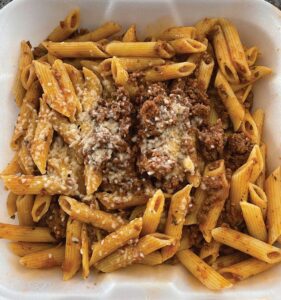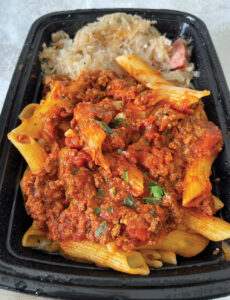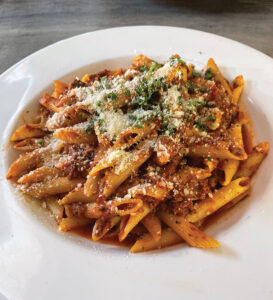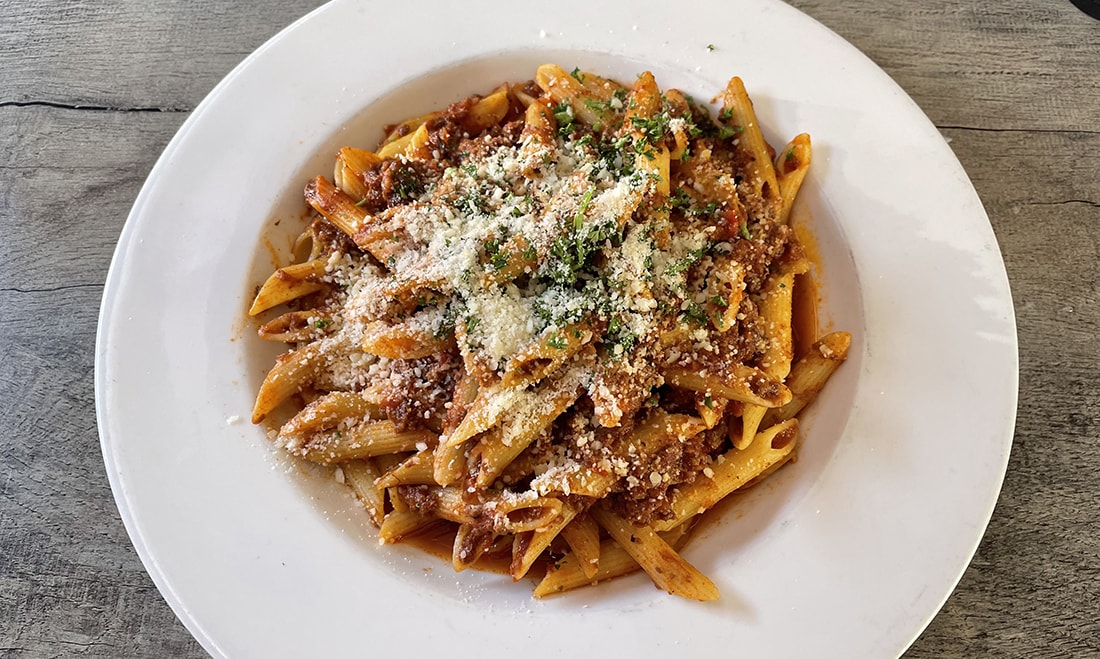The first time I saw mostaccioli on the Dalmatian-American Club’s buffet menu, I assumed it was the Southern Italian cacao and spices-based Christmas cookie because of my Italian upbringing. Imagine my perplexity when it turned out to be pasta with meat sauce.
I didn’t think much about it or wonder how an Italian-sounding dish found its way on a Croatian buffet until my editor suggested I write about mostaccioli. This left me more perplexed than the scenario above because, at the time, I questioned the relevance of writing about penne pasta served with meat sauce.

Mostaccioli from the Croatian American Club. (photo: Sanam Lamborn)
Although I started talking to folks about mostaccioli and tasting the various options around town months ago, I postponed writing this article because it remained directionless. However, everything changed after a conversation with Michelle Petrich, whose daughter Marina Petrich noticed the absence of mostaccioli on menus during a recent visit to Croatia. This piece of information sparked extensive research encompassing articles, online forums, consulting Croatian cookbooks and the Around the World, Around Our Town series available at our San Pedro library, and surveying people around town — which allowed me to understand why mostaccioli is so beloved.
I discovered that some people simply call the shape of the pasta — smooth, long pointy tubes — mostaccioli. Others call the whole dish — pasta and meat sauce — mostaccioli. Nevertheless, mostaccioli-shaped pasta is only served with meat sauce. What I knew going in is that a type of pasta named mostaccioli does not exist in Italy. However, in the U.S., Barilla and a few other companies sell a version of the smooth pasta. Penne pasta has always been a convenient substitute.
I began with one hypothesis: Mostaccioli is a Croatian-American dish. This turned out to be true — to a certain extent. A commonality among the Croatian residents I surveyed for this article was that they grew up eating mostaccioli every Sunday and holidays. The Sunday family meal was a popular tradition amongst the first generation of immigrants but seems to have lost its way for subsequent generations (late baby boomers and beyond) who, at best, make mostaccioli once a month. Still, it remains a staple for holiday meals. Nevertheless, mostaccioli is a cherished dish in the Croatian-American community, one that is often associated with large bubbling pots on the stove, nostalgic memories of a nonna or baka (“grandmother,” depending on regionality) lovingly cooking while the aroma filled the home.
None of the cookbooks I consulted include the word, much less a recipe for, mostaccioli; the closest is a pot roast and spaghetti sauce recipe submitted by Dolores Lisica in the 1986 edition of Around the World, Around Our Town. Nonetheless, mostaccioli is made by simmering onions, garlic, tomato sauce, and the cook’s preferred meat. Some add wine for a richer flavor. Some only use ground beef, while others add beef chunks or short ribs that, once cooked, are shredded and added back into the sauce. Depending on the cook’s preferences, veal, pork, and lamb are options.

Zeb’s Kitchen’s mostaccioli. (photos: Sanam Lamborn)
The first homemade mostaccioli dishes I tried were made by Zeb’s Kitchen’s professional chef Josetta Spychaj and Mrs. Spicy Cro. Spychaj’s recipe is passed down from her nonna, who owned the Fishermen’s Cove in Terminal Island, which many cannery workers frequented. Her recipe is made with 80/20 ground beef or brisket on special occasions. Mrs. Spicy Cro only uses ground lean top sirloin from South Shores Meat Shop. She adds butter at the end for added moisture and flavor and a good amount of parmesan cheese.
Bridget Mirkovich-Smith believes the sauce should have “a rich, salty meat flavor base, rather than a sweet tomato flavor.” Maryann Berkovich says, “What makes a good sauce is a lot of onions, parsley, basil, and a little red wine.” Kathy Creighton tells me mostaccioli, also referred to as gravy, is “brown and actually has very little tomato sauce.” Additionally, her nonna used to cut the acidity of the tomatoes with a bit of cinnamon.

San Pedro Café’s mostaccioli. (photo: Sanam Lamborn)
Most Croatian Americans prefer homemade mostaccioli because it tastes better. If they venture out, it’s during events at the Croatian American Club (631 W. 9th St.) or the Dalmatian-American Club (1639 S. Palos Verdes St.). San Pedro Café (605 S. Pacific Ave.) is the only Croatian-owned restaurant in town that has mostaccioli permanently on the menu. The Croatian American Club’s version is deep brown with a generous amount of ground beef, and you can tell it has had a long simmer. It’s the greasiest I have had, but it’s all good flavor. San Pedro Café’s has a deep red color and shredded spare ribs, which add a welcome depth of flavor. It’s then finished off with fresh parsley and parmesan cheese.
Does mostaccioli exist in Croatia? I have received mixed responses. It gets better. In my research, I came across two plot twists that require a part two to this article: Italian Americans also have mostaccioli; so do Midwesterners, but their version is baked, while the Croatian American and Italian American versions are not. Stay tuned! spt







Comments